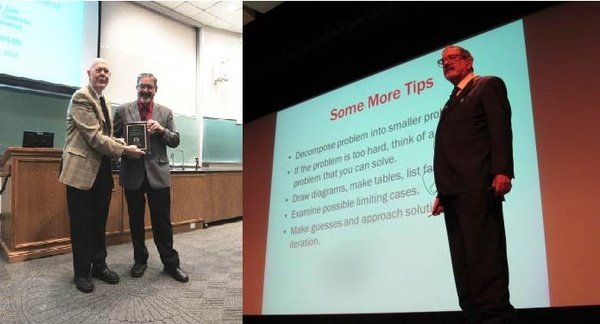Richard Zare Inspires BYU
Feb. 14, 2012

The fifth annual Reed M. Izatt and James J. Christensen Lecture Series were given by Richard N. Zare on February 7 and 8. Zare is a renowned chemist who has had a long and successful career. He is currently a professor of chemistry at Stanford University.
Zare’s first lecture, written for a general audience and delivered in the Wilkinson Student Center, was boldly titled, “How to Be Successful.” As the recipient of numerous awards (including the National Medal of Science in 1983 and the Priestley Medal of the American Chemical Society in 2010), Zare would seem uniquely qualified to deliver such an address – but the professor never presumed he could give attendees all the answers. Instead, the talk focused on tips for dealing with and solving problems.
“There is no question that life is full of problems and problematic solutions,” Zare wrote in his lecture abstract. “I suggest that these same tips [for problem solving], when vigorously pursued, lead to happy outcomes, whether or not a particular problem gets solved. They lay the basis for a wonderful life of the mind.”At the beginning of “How to Be Successful,” Zare offered a copy of his PowerPoint presentation to anyone who asked. Following the presentation, he received 44 requests, many of which were accompanied by comments like “Your presentation inspired me,” and “Thank you for your insights.” One man, an Orem resident who attended the presentation, wrote, “Your thoughts rang true for me, though I am no chemist, or college grad. Your words were easily adaptable into all areas of life. Well done, and thank you for your thoughts.” A student added: “I agree that problem solving is a very useful tool, once I understand the concepts, I can apply them to whichever problem I choose which has the same concept underneath.” Problem solving was also highlighted in Zare’s second seminar, a technical lecture given in the Benson Science Building to interested students and faculty on Feb. 8, in which he described some of the work going on in his laboratory at Stanford. In particular, Zare discussed the use of desorption electrospray ionization (DESI) to record short-lived intermediates in liquid chemical reactions. “Without measurement we cannot have science, and nothing so much stimulates new measurements as inventing and perfecting new measurement devices,” read Zare’s second abstract. At the beginning of his second lecture, emeritus professor Reed M. Izatt presented Zare with a plaque commemorating him as the Izatt-Christensen lecturer for 2012.
The Izatt-Christensen Lectures are named after two foundational members of the university, Reed Izatt of the Department of Chemistry and Biochemistry and James Christensen of the Department of Chemical Engineering. The two professors started a joint research program in chemical thermodynamics and chemical separations which received international recognition. The long-time colleagues also guided more than 60 graduate students through their M.S. and Ph.D. degrees in chemistry and chemical engineering during their time at BYU. Christensen passed away unexpectedly in September 1987.
By Jessica Henrie
Photos by Alexis Hales
Video by Wilkinson Center events staff